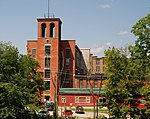Southbridge Municipal Airport
Airports in Worcester County, MassachusettsMassachusetts building and structure stubsMassachusetts transportation stubsNortheastern United States airport stubs

Southbridge Municipal Airport (FAA LID: 3B0) is a public airport located two miles (3 km) north of the central business district (CBD) of the Town of Southbridge, a city in Worcester County, Massachusetts, USA. The airport is owned and operated by the Town of Southbridge and overseen by the Southbridge Municipal Airport Commission. It covers 229 acres (93 ha), has a single runway, averages 142 flights per day, and has approximately 30 aircraft based on its field. The airport sustained damage on June 1 from the 2011 New England tornado outbreak.
Excerpt from the Wikipedia article Southbridge Municipal Airport (License: CC BY-SA 3.0, Authors, Images).Southbridge Municipal Airport
Airport Access Road,
Geographical coordinates (GPS) Address External links Nearby Places Show on map
Geographical coordinates (GPS)
| Latitude | Longitude |
|---|---|
| N 42.100833333333 ° | E -72.038333333333 ° |
Address
Southbridge Municipal Airport
Airport Access Road
01550
Massachusetts, United States
Open on Google Maps










